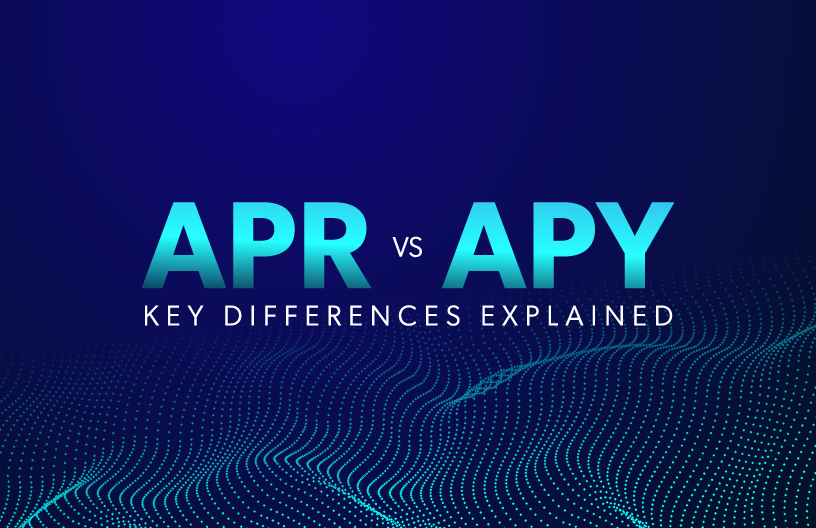Imperial College London and FluidAI Announce Groundbreaking AI Partnership! Read here 🤝

APR vs. APY: Key Differences Explained
Annual percentage rate (APR) measures the interest you'll be charged when you borrow
Annual percentage yield (APY) measures the interest you earn when you save

APR vs. APY: Key Differences Explained
Summary:
- Annual percentage rate (APR) measures the interest you’ll be charged when you borrow
- Annual percentage yield (APY) measures the interest you earn when you save
- The lower the APR, the less you may have to pay interest when you borrow. And the higher the APY, the more you earn in interest when you save.
When it comes to understanding the world of finance, there are several terms that can be confusing, especially when they sound similar. Two such terms are APR (Annual Percentage Rate) and APY (Annual Percentage Yield). Although they both represent the annual interest rate or return on financial products, they have significant differences in their calculations and what they represent. In this blog post, we will explore the differences between APR and APY, address common questions, and shed light on their significance in the crypto landscape.
What is APR?
The Annual Percentage Rate, or APR, is the less complex of the two metrics. This applies to loans or other borrowing types such as personal or credit card debt. APR is a comprehensive metric that incorporates the base interest rate and other expenses like fees and insurance.
Usually, it refers to monies borrowed through credit cards, auto loans, personal loans, mortgages, student loans, lines of credit, or lines of credit for home equity. The APR calculates the interest you’ll pay on any loan. So you could have to pay less interest if the APR is lower.
According to the Consumer Financial Protection Bureau, “APR is a broader indicator of the cost of borrowing money” compared to an interest rate. This is because APR can include the interest rate and other expenses like closing costs, insurance, and lender fees. The APR and interest rate may be the same if no lender costs are included in the APR, as is frequently the case for credit cards.
When evaluating some credit options, like those for vehicle finance, the APR may be more helpful than the interest rate because it may consider expenditures like lender fees.
What is APY?
The Annual Percentage Yield, or APY, is the second widely used metric. Unlike an APR, this is used for investments you make or money you get. It is often referred to as EAR or Effective Annual Yield.
You will make more money each year if the APY is higher. However, APY stands out since it takes compounding into account. The advantage of reinvesting your earnings at predetermined intervals is therefore included.
APY may demonstrate how much interest your investment might generate annually. In general, the higher the APY, the greater the interest generated by your investment but remember that the amount of money you have in your account will also affect how much you make.
In addition to the interest rate, the APY considers compound interest and how frequently it occurs in a year. Therefore, you receive interest on more than just the initial deposit when you receive compound interest.
Because it considers compounding, APY can be more valuable than the interest rate when comparing deposit accounts. For example, say you compare two deposit accounts with the same interest rate. The APY might show that the one that compounds daily would earn you more interest than the one that compounds annually.
Keep in mind that the APY for a deposit account is usually variable. That means APY can change and fluctuate with the market after the account is opened.
Why is APR Higher than APY?
APR is typically higher than APY due to the nature of their calculations. APR considers fees and costs associated with borrowing, while APY takes compounding into account. The compounding effect can boost the overall return, resulting in a higher APY compared to the nominal interest rate.
APY and APR: Are They the Same?
No, APY and APR are not the same. As mentioned earlier, APR represents the cost of borrowing, while APY represents the return on investments. While they are both expressed as annual rates, their calculations and purposes differ.
What is APY vs. APR in Crypto?
In the world of cryptocurrency, both APY and APR play important roles. When it comes to staking, which involves holding and validating cryptocurrencies, APY is commonly used to measure the annual return on the staked assets. It takes into account the compounding effect and provides investors with an estimate of their potential earnings.
On the other hand, APR in crypto trading refers to the annual interest rate charged on margin or leverage trading. It represents the cost of borrowing funds for trading purposes. Traders need to consider the APR when engaging in leveraged positions to assess the potential costs involved.
APY vs. APR in Staking: Understanding the Difference
In staking, APY and APR are used interchangeably to express the potential returns on staked assets. Both metrics provide investors with an estimate of their earnings. However, it’s important to note that APY factors in compounding, giving a more accurate representation of the actual return over time.
APR vs APY in a Nutshell
Understanding the differences between APR and APY is crucial for making informed financial decisions. While APR helps you compare the costs of borrowing, APY provides insights into the potential returns on investments. Both metrics play vital roles in different areas of finance, and knowing how they are calculated and what they represent can empower you to make better choices.
Whether you’re applying for a loan, managing your credit card debt, or evaluating investment opportunities, having a solid grasp of APR and APY will enable you to navigate the financial landscape with confidence. So, the next time you encounter these terms, you’ll know exactly what they mean and how they impact your financial journey.













